This is part 5 of Quickstart Guide: How to boost your personal productivity with A.I. tools
Nothing boosts productivity like delegation. I mean, if productivity is value produced over amount of time that took, then reducing the denominator – the time – to all but zero sends the ratio through the roof. Paul Graham of Y-Combinator fame even joked once that the best way to increase one’s productivity is to have kids – that reduces time available to anything else to pretty much zero, so if you manage to accomplish anything at all, your productivity would be close to infinite.
Let’s see what kind of tasks we can offload to A.I.
… curating human connections
Your connections with other people might easily be your most valuable asset. From getting motivated to getting unstuck to getting known, reaching out to a trusted human being is your surest bet. And like nowhere else, quality here beats quantity every time. But you may have to sift through considerable amount of all kinds of people before you find the few you click with. And when it comes to sifting through large amount of data, nothing beats A.I.

Etch, for example, “helps you automate four of the most painful” parts of managing your connections:
- Merging and de-duplicating contact info from multiple sources
- Enriching profiles with professional biographies, skills, interests, expertise and social media updates
- Having a single timeline of interactions – emails, calls, and meetings
- Searching for people based on all of the above
Bonus: Etch have very straightforward privacy and security policies: none of the data ever leave your smartphone.
Trove digs deeper. They see email as the largest and the most valuable information store on the planet, and they are on the mission to create A.I. technology to extract that value from that store. By now, Trove can measure not only strength of your connections – based on how often you communicate and what is the usual response time, but also what connections helped you the most in building your network, and what would be the best way to meet someone. This is the most powerful in the context of a group of people who can share connections – say, a company – but works pretty well for individuals as well.
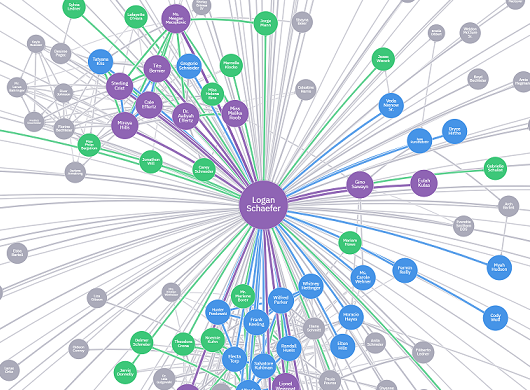
Bonus: Trove has also put some smarts into how it handles your incoming email – from highlighting outstanding questions and more important emails to cleaning up less important ones with a single swipe.
… processing inbox
Speaking of handling the incoming email… It is responsible for countless hours wasted (re)reviewing the messages in fear of missing an important one – and for continuous distraction caused by the notifications we are setting up, again, in fear of missing an important message. The truth of the matter is that no matter how important is an email, it’s unlikely to be urgent – otherwise you’d get a phone call and not an email, don’t you think? So, it’s safe to turn off email notifications wholesale, and schedule half-an-hour during a downtime to sort through the inbox.
But wouldn’t it be great to be done with that in like 5 minutes, and get back one Pomodoro of your life? Is it even possible? The Pareto principle (also known as 80/20 rule) comes to the rescue. Cover 80% of value by personally handling only 20% of the volume, and delegate sorting of the remaining 80% to get to the inbox zero. Let’s see how A.I. can help here.
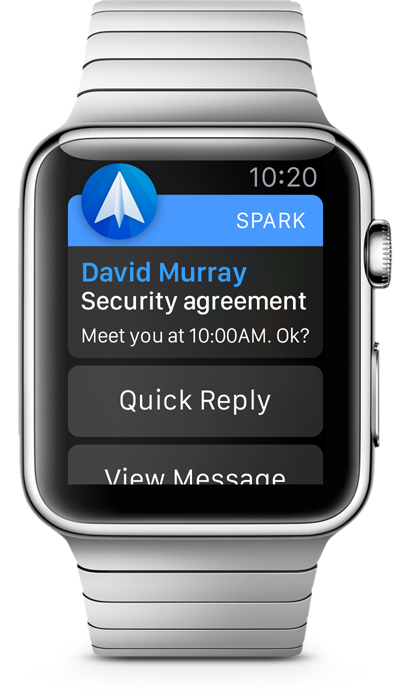
Spark intelligently bubbles the most important messages to the top of the inbox, as well as organizes the inbox into sections like Personal, News, Notifications and Seen (for batch delete or archive). Besides, it allows you to use natural language while searching for messages. And to save even more time on quick ‘politeness’ responses, you can reply with one-tap emoji.
Bonus: To ease your way into notification-less email, you can configure Spark to notify you only about messages from real people – you’re likely to cut the amount of notifications by 80% while still getting 80% of important emails right away.
In case you indeed happen to have (objectively or subjectively) urgent emails in your inbox, Knowmail can identify these and notify you promptly. This A.I. technology aims at highly personalized prioritization of the incoming messages “by the individual’s state-of-mind and availability, including time-saving predictions for frequent actions”. Just connect your email with Knowmail, and at any moment you could ask your favorite voice assistant (or your favorite messaging app) to if there any urgent emails for you – without risking being sucked up by your vast inbox. Besides, the company is committed to treating emails as a business asset that “may contain private, confidential, and even intimate information” – which makes it suitable (and most powerful) for handling work emails.
Bonus: In case you are serious about bringing this advanced technology into your organization, Knowmail can work its magic in the background, behind usual Microsoft Outlook email client interface, without data ever leaving the premises.
Love your email client, but still want to have the email sorted for you? Meet SaneBox. You keep your favorite email app, just allow the SaneBox move messages from the inbox into a folder it deems appropriate – that’s it! If any message is ever mis-categorized, just move it to the right folder – SaneBox would notice and learn.
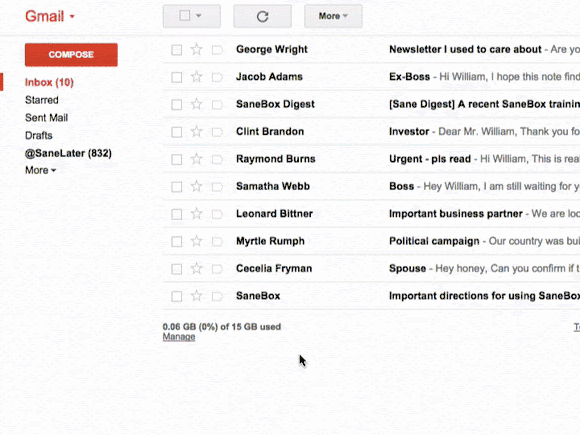
Bonus: SaneBox can also automatically store email attachments in your Dropbox, stretching for a bit longer that free storage allowance from your email provider.
… scheduling meetings
But there is still a whole class of emails that are important, sometimes urgent, and (at least until recently) required human handling – namely, meeting scheduling ping-pong emails. Scheduling with another person takes on average 3 back-and-forth emails, and constant consulting with your calendar. Here are a few A.I. assistants that free you up from that chore of the past.
Amy or Andrew (amy@x.ai and andrew@x.ai respectively) will gladly do the meeting time negotiation on your behalf – all you need to do is to CC: one of them on the email thread and ask them to take over. As with any assistance request, be sure to specify any details of this particular meeting that you care about. As to the general guidance about, say, breather time between meeting – you can set this via web interface once and for all. A successful negotiation results in an invite emailed to all parties. And as any good assistant, Amy (or Andrew) will reach out back to you if there is something they cannot handle on their own – like a question from an invitee about purpose of the meeting. By the way, their last names are Ingram, but it’s not clear how exactly Amy and Andrew are related to each other.
Source: x.ai
Bonus: Essential x.ai services are FREE, and meetings with other participants of x.ai network are scheduled instantly!
x.ai assistants are fully automated, which allows them to be priced very competitively and offer unlimited number of scheduling requests. The downside is that accuracy of the results is still to match the accuracy of human assistants – or hybrid ones. Clara.Lane@claralabs.com is one such hybrid human-in-the-loop scheduling assistants. It shows 97% accuracy and response time of about 20 minutes. It also noticeably more human in the whole process, and some even report that having Clara in the team mitigated the need for a full-time employee – which, you’d agree, is a steal at pretty much any monthly service charge.

Bonus: Some paid plans support “codewords” – a phrase in the email requests that triggers certain customization. For example, “really booked” might mean that the meeting request should be scheduled not earlier than in one month.
And if you are ready to level up your “manage my calendar for me” game (or need A.I. assistant fluent in both English and French), contact Julie@JulieDesk.com. Not only Julie knows how to handle gracefully less detailed requests, like “something popped up, reschedule all my today’s meetings” or “this meeting is top priority, just reschedule what I have to make it work”, she can update your calendar with whatever info you throw at her.

Bonus: Julie’s favorite movie? Her

Emma offers somewhat complimentary service to meeting scheduling. Once connected to your Google calendar, it updates it with time it will take you to get to the the meeting points. ‘Cause it’s no good to receive the appointment reminder 15 minutes before the appointment if it’d take you 40 minutes to get there, right? And even if you budgeted these usual 40 minutes while reviewing your daily agenda in the morning, you’d still be glad to get notified that due to current traffic situation it’s more likely to take you about an hour. It’s all these travel schedule management that you can delegate to Emma. It would consider multiple modes of getting from here to there – public transit, driving, cycling and walking. And as a good A.I. assistant, it learns your preferences over time.
Bonus: Emma doesn’t require you to install any app and doesn’t ask any questions. It just looks at your calendar and updates it with the travel suggestions – which you are free to ignore or adjust, of course.

And since we touched upon the topic of assistance with travelling, I’d like to quickly introduce Mezi – 24/7 personal travel concierge. It can help you with flights, hotels, event tickets and dining reservations. One communicates with Mezi via a chat-like app, where the in-chat forms allow you to enter the details of the trip or the event quickly. Similarly, the forms allow you to finish the booking with only a couple of clicks (Mezi doesn’t overwhelm you with the options – it presents up to 3 best ones, for example cheapest flight, shortest flight and flight with your preferred airline). And it’s backed with human experts, so on a rear occasion when the dialog gets nowhere, you see them coming to the rescue pretty quickly.
Bonus: While researching your options, Mezi takes into account any membership or rewards points you might have.
… pretty much anything that can be done online
Actually, once a service has human in the loop, that can not only smoothen out idiosyncracies of machine intelligence while scheduling meetings. It allows the hybrid system to take on pretty much any assistance request, while keeping the whole process cost-efficient by delegating what’s possible to A.I.
That’s what Invisible does – combines 24 x 7 x 365 availability of a digital assistant with flexibility of a personal assistant and reliability of a team of assistants. (The usual trade-off between a personal assistant and the team of assistant is that the former is more likely to get to know and serve you better, while the latter reduces the risks of a “single point of failure” in getting the tasks done. Invisible gets the best of both worlds by learning and remembering your preferences in a formalized way.) It effectively hides behind simple on-demand pay-as-you-go interface all the complexity of hiring, training and managing an assistant . You just email your request to your personal bot, and pay for the time Invisible agent worked on it. Invisible estimates that about 41% of workload of an average knowledge worker can be delegated – at about 28% of the cost.
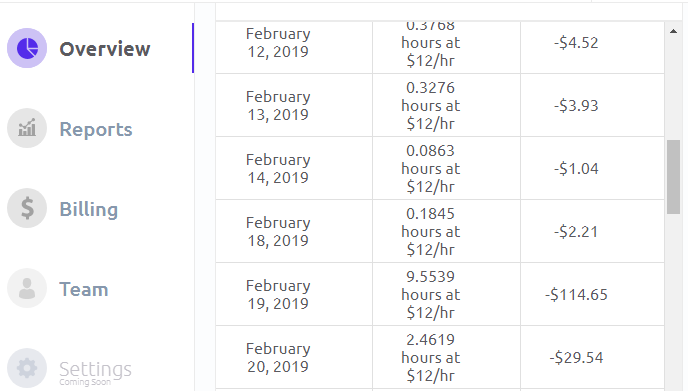
Bonus: Invisible is on the mission to make task delegation as easy (and as cost-effective) as getting a ride with Uber and Lyft. If you ever had to use regular taxi instead of Uber (especially in suburbs), you’d know you are up for a treat with outsourcing your menial tasks to Invisible.
… transcribing and note taking
But there is another advantage pure A.I. assistant offers over a human or a hybrid assistant (besides being more cost-efficient) – confidentiality. ‘Cause sometimes you just want to keep the things between the two of you.
For example, Whipnote – service that transcribes conference calls in real-time (think closed captioning) – guarantees that no human will ever be involved in data handling. You just add notes@whipnote.com to your calendar invite, and it will join the call (even if you are late!) and transcribe the conversation. The trade-offs, as expected, are about 90% accuracy even with minimal background noise, clear voices and minimal accents.

Bonus: To offset the non-perfect transcription, you can become the human in the loop and, quote, “annotate the real-time transcript during your call, so you have complete and accurate notes, with little typing.”
Tetra is a more hands-on version of the same service (you need to dial-in through their app to get the call transcribed) and not as real-time (you get the notes about 10 minutes after the call, although you can put a bookmark in the notes with a single tap while on the call). On the upside, it offers a number of post-processing artifacts, like automatic extraction of keywords, generation of call summary and advanced search. It uses Deep Learning for speech recognition – one of a few domains that suite uniquely well for this IMHO overhyped technology, so I expect the accuracy to improve considerably over time. And like with Whipnote, the data handling is 100% automated.
Bonus: It makes the transcript much more readable by labeling the speaker.

And Otter is on the mission to make our voice communications as persist-able, search-able and share-able as our written ones. And as visually rich too – the transcripts are synced with photos, so any snapshots you take during, say, a presentation (given that you managed to place your smartphone within 3 feet of the speaker) become part of the narrative. You can imagine how convenient these notes become when you want to share a presentation with your team or bring somebody up to speed on a brainstorming session s/he missed. Again, Otter promises to involve humans into transcription of any part of your recordings only with your permission.
Bonus: Otter neatly organizes all the notes and allows them to be exported in full as a file (say, into Evernote), or shared via a URL (Evernote-style, so that you don’t need to install an app or even login to view the note).
But let’s say you already have a recording of a speech or conversation, and all you want is to get good transcription of it. The go-to transcription service Rev would charge you $1/min, and the resulting transcript won’t be even public-ready – despite the fact that it was prepared by a human. If you have to edit the transcript yourself anyway, why can’t you just get the 80% of work done quickly and cheaply?! Well, who said you can’t? You can – use Temi. It costs a fraction of what Rev would charge you, the transcribing process takes fraction of the length of the recording, and their interactive editor even syncs the transcription with the recording! If you ever tried to edit a transcription, you know what a pain it is to locate the snippet that corresponds to some “inaudible” text. If you never tried that – don’t do that without Temi 😉
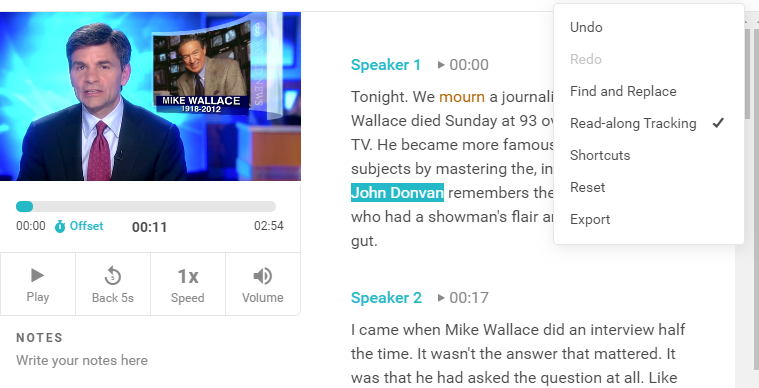
Bonus: It even highlights the words it suspects it didn’t get right.
Don’t need the interactive editor, want to just put recordings file in and take the text file out? Rev.ai would do just that – at a fraction of the Temi price tag.
… typing and point’n’clicking
But the original application of voice recognition technologies was, of course, dictation. (Does anybody remember Dragon NaturallySpeaking? Well, it’s still around!) You can surely use Otter to transcribe your own speech – effectively delegating typing to the machine. And unlike using a voice typing built into your gadget’s operating system, you’d also get the voice recording as a backup, that could be used to clean up the transcript if need be.
Want to dictate in a language other than English? No problem! The built-in dictation mode is likely the most accessible option – Google Voice Typing, for example, supports over 120 languages time I checked. Alternatively, you can use Dictation.io website – it’s based on Google Speech Recognition engine and supports the same set of languages. If you prefer to have the monologue recorded for backup purposes, just record the file with your software of choice, and upload it to Google Cloud Speech-to-Text for transcription.
Then, there is a number of PC-based options, from veterans like Dragon to newcomers like Briana. One interesting feature of latter is that it allows you to operate the PC with voice commands – do things like “Open E drive” or “Play video Thriller” or “Google world cup schedule” or “Minimize window” or even “Shutdown computer”. No microphone on your laptop? Briana Android and iOS apps turn your smartphone into wireless microphone, so that you can control the PC over WiFi! What practical joke are YOU thinking about now, eh?
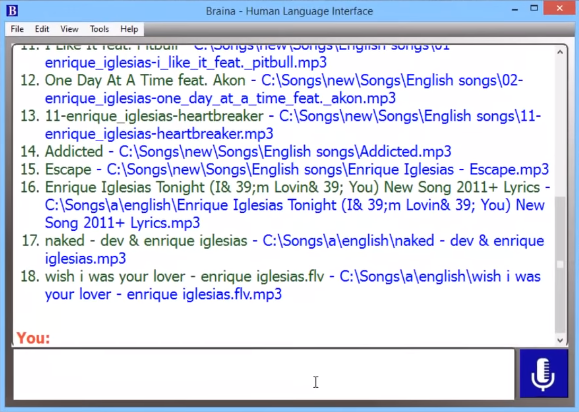
Bonus: You can voice-control PowerPoint deck – as if you would be talking to an assistant sitting behind your laptop! Eat this, Google Assistant!
Of course, Google Assistant should have come up – all this “control with your voice” sounds way too familiar. Indeed, it can save you a lot of tapping you’d otherwise had to do to “text mom I’ll be in 10 minutes” or to learn “when the closest library closes?”. At home, it can even save you a trip downstairs to “check if the front door is locked” (yes, I know, we all could use a little bit more walking around, but not at 10pm when you are already in bed). It can even save you wiping that BBQ sauce off of your hands when you want it to “play favorites playlist” – in case you have Google Home sitting nearby. Although the idea that this thing might be listening and sending to Google everything I say creeps me out.
Bonus: Yes, Google Assistant can even be installed on your laptop.
What is annoying about these smartphone voice assistants is that they require Internet connection to do a-nee-thing! Even if you’re just asking to open an app that is already on your phone, without Internet they wouldn’t even parse – leave alone understand – what you are saying. Com-mon! Smartphones have more computing power than spaceships!.. Shouldn’t they be somewhat intelligent on their own, without umbilical connection to zee cloud?!
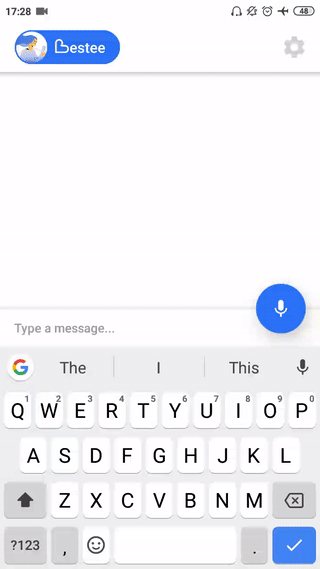
They should, and they are – with the right apps, that is. Meet Bestee – instant offline personal assistant. Not only it can understand you – and speak back to you – without using a single byte of your data plan, the responses are lightning-fast! Offline also means that all your messages and information stay on your device, safe from Big Tech and zee hackers. But it doesn’t mean that it’s disconnected – it’s perfectly aware of your smartphone ecosystem, and collaborates very well with your apps. Overall, Bestee does feel like a truly personal assistant that is always there for you – readily serving you, checking on you, cheering you up with a joke or even offering an advice when you are not feeling well.
Bonus: Bestee aims to be emotionally intelligent as well, e.g. by adjusting her communication style to yours – and speaking in voice only when spoken to first!
… searching for that file or photo
A.I. understanding of natural language doesn’t only save you typing – it can save you learning another language. It could be another human language – or a hundred human languages in case of Google Translate. Or it could be a formal query language, like a language you can use to search e.g. for emails with YouTube videos that you have missed in the past month. (Hint: in Gmail the query would look like this: has:youtube is:unread newer_than:30d)

Findo is like Google Translate for search query languages. Fluent in Googlese, Microsoftian, Evernotish and many others, it allows you to search for files and messages using plain English. You can, for example, ask to “find presentation from a guy from Boston I received a week ago” or “find photo from Sarah from last month”. Findo can connect to any and all of your file and message silos – like your laptop hard drive, pretty much any cloud file storage, pretty much any email provider and pretty much any messenger – and search all of them at the same time from one place. And one place doesn’t mean only the laptop – you can make your search requests via web site, mobile app, Slack, Telegram, Facebook Messanger, Skype – and have the results delivered right then and there. All this while keeping you data highly secure with state-of-the-art methodologies and tools.
Bonus: If you searched from mobile app and the search results include file stored on your laptop local drive, you can still get hold of the copy of the file. When they say that Findo makes your information accessible to you everywhere, they mean it!
Zoolz searching superpowers are of a different kind. Its A.I. tags your photos with faces it sees on them. It doesn’t place names to faces (you do that, if you want), but it does try and match the same face on different pictures. As a result, you have a gallery of faces, and can retrieve all pictures featuring the holder of a face with a single click. It also conveniently shows faces that share photos with a given one.
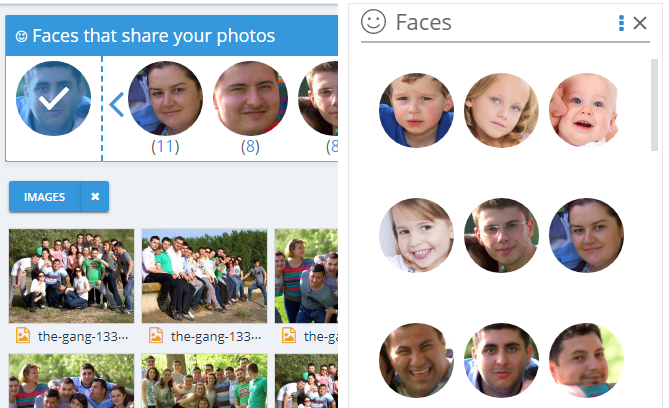
Bonus: Your pets will also show up in the gallery. Besides, you can find photos by objects that appear in them – like ‘cup’, ‘phone’, ‘glasses’ etc.
… designing a preso or a website
While NLP assistants might save us minor inconveniences, they would not move the proverbial needle. What would really help is an assistant that takes care of the beautification (and/or, more importantly, takes away our worries about the beautification) and lets us focus on the essence of our work. Here are a few of those.
Beautiful.ai takes pride in making your slides look “clean, modern, and professional” – by automatically applying the best design practices to your very own presentation. Get a head-start with one of 50+ “smart” templates – and watch the slide design adapt to the content you are adding. It’s like collaborating with graphics and animation designer – in real-time!

Bonus: It comes with a huge library of images and icons – one-stop shop for making the brilliance of your idea shine through.
Similarly, Bookmark’s AIDA – AI Design Assistant – builds a professionally looking website template specifically for you. Surely, there is no shortage of website templates, but which one would work the best in your case? AIDA lets you iterate quickly through the most suitable options. Just let it know the idea of the website, and let AIDA quickly put together a design. Don’t like it? Just let AIDA know, and it’ll come with another one. Like the design, but want to tweak a thing or two? Just drag-and-drop, no coding skills required. You’ll have the template you’ll love in no time – now get to work and make it real with your unique content.
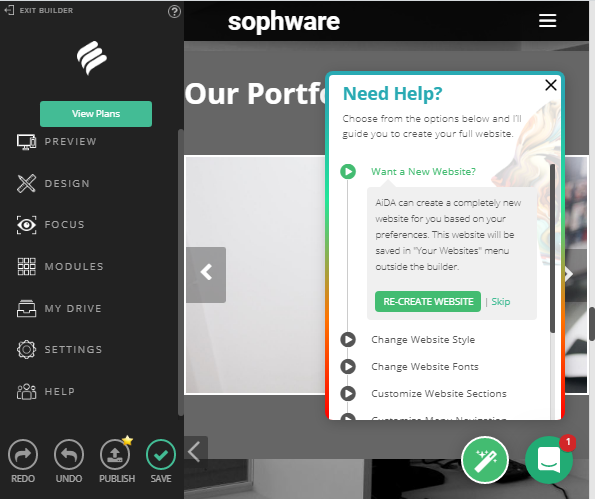
Bonus: You can host your freshly build site right there on bookmark.com – again, they aim to be the one-stop shop for building bridgehead of your online empire.
While it’s possible to delegate creating the content to an A.I. system like Heliograf or Wordsmith or AI Writer, I don’t think you should do that. First of all, you don’t want machines to have all the fun, do ya? Secondly, robots’ ventures beyond reporting on factual stories are strange at best and extremist at worse. But most importantly, with your content you don’t just deliver information (Goolge does that) – your competitive advantage is transformation. Cannot outsource that!
That said, what A.I. can help with is to get you into the flow of creating. Specifically, Brain.fm creates a soundtrack that keeps you distraction-free and focused for hours in a row. It effectively creates a personal composer for you, that is seeded with your answers on the initial questionnaire and improving with the feedback you give it for music composed. What I particularly like about this A.I. system is that it has scientific research in its foundation, and not just anecdotal findings of (deep) neural network in a massive dataset. The role of A.I. here is rather to personalize the application of the theory for the given individual – via assembling flow-inducing soundtrack.

Bonus: Brain.fm can also support you during the periods of relaxation, meditation, recharging and sleep. Try it – it’s “designed for noticeable results within 15 minutes or less”
… investing money
Investing money is another of those simple but hard activities. It’s simple because it’s just a matter of keeping your asset allocations on target – that is, making sure that, say, bonds are pretty much always 30% of your portfolio and stocks are 70%. The hard part is to figure out what this target allocation should be to match your idiosyncratic appetite for risk and return, and then efficiently trade the assets when the market moves meaningfully. A.I. systems are uniquely well positioned to do both – by analyzing vast amount of historical data across a number of asset classes, and by not getting emotional at the times of inevitable drawdowns. They are called robo-advisors.
Both Betterment and Wealthfront make set-it-and-forget-it investing services – previously accessible only to ultra-wealthy – ridiculously affordable (with no minimum to open Betterment account and no fee up to $10K on Wealthfront account). And you don’t even have to sign up to see the portfolio they recommend – just take free risk assessment that takes only a few minutes. Both show you trajectory of your potential returns, but Wealthfront also shows how big decisions – like buying house or paying for college – impact your net worth.
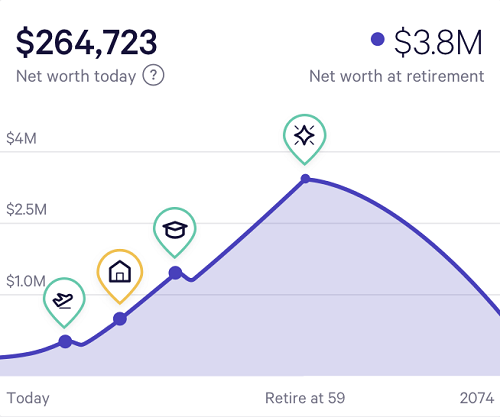
Both offer tax-advantaged (IRA) accounts and easy rollover processes. And for taxable accounts, each offer its own flavor of Tax Loss Harvesting – another advanced strategy that would be prohibitively expensive wouldn’t it be implemented with A.I.

Bonus: This services all but force you to define your investment goals – a Very Good Thing in and of itself. If you decide to give Betterment a try, consider using my referral link – we both will get 90 days for free.
Now, Betterment and Wealthfront are practicing what’s called ‘passive investing’ – they maintain the decided upon assets allocation (via low-cost well-defined index ETFs) by periodic rebalancing. Very systematic and reasonable approach – rebalancing effectively “sells high” the assets that moved above their target allocation and “buys low” those that are relatively cheap now. (That is, say, partially cash out stocks that grew to be 80% of the portfolio instead of target 70%, and re-invest the proceeds into bonds that should bounce back, statistically speaking). The problem with passive investing is that very few humans have the nerves to follow through with it during prolonged draw-down periods, when they see the overall value of the portfolio shrinking. Hence the alternative – ‘active asset management’ – where assets are periodically re-evaluated and judgement call is made about the new allocation. The only problem with this one is that historically, active managers underperform passively managed benchmarks. Now what?
SoFi Wealth offers a “best of the both world” strategy they call “active management of passive assets”. Meaning, they still invest your money into (passive) low-cost index ETFs, but have flexibility to change (actively) the mix of funds in a given portfolio. As such, they setup your portfolio not as a set of exact weights of different ETFs, but rather via an chosen risk level (5 levels from Conservative to Aggressive) and type of taxation (regular or IRA). And why they think that they could outperform the passive benchmarks? Very low management costs. The reason the passive benchmarks beat typical active management is not actual assets selection, but rather high management fees and trading costs that the latter entails. SoFi’s use of advanced technology allows to bring the management fees all the way down to the robo-advisor level. And the fees are waived completely for the first $10K, or while you are a SoFi borrower. It is “best of the both world” in another sense as well – SoFi’s hybrid system combines powers of machine learning and human judgement.
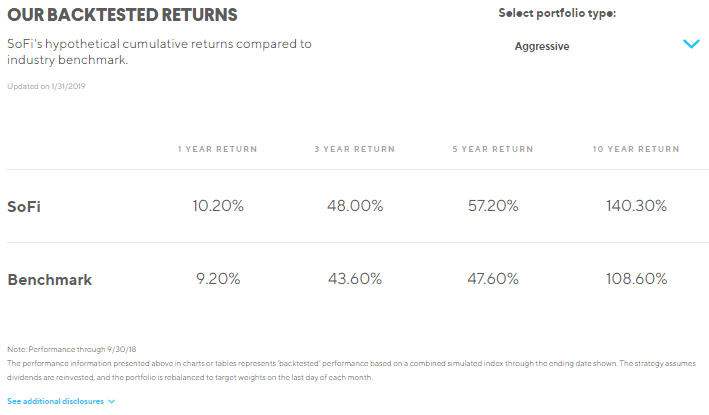
Bonus: In the 1+1=3 style, SoFi borrowers get rate discount on their loans when they become SoFi investors.
Responsive is another example of hybrid active portfolio management service. “Using artificial intelligence (AI), [Responsive.AI] expert team monitors hundreds of signals to make the best decisions during market turbulence and market opportunity.” It’s a bit more expensive than a typical roboadvisor, but it offers downside protection that typical roboadvisor doesn’t. Indeed, wouldn’t you want your portfolio be shaped like this on the fall (pun intended) of 2008?
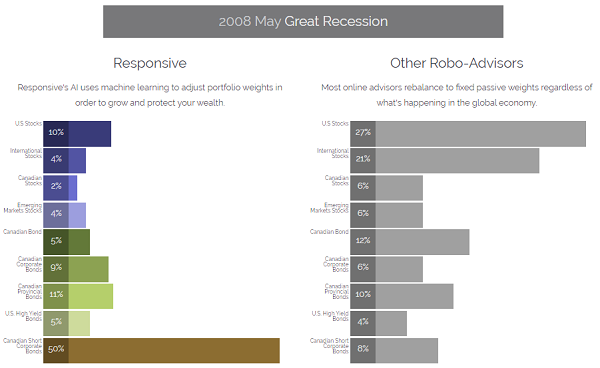
Anti-bonus: At the time of the writing, the service is available only to Canadians.
Speaking of robo-advisors not available to U.S. persons – meet Selma. After a quick robo-chat designed to determine your risk tolerance, it offers a portfolio that you can test drive with virtual money. Selma is based in Switzerland and detects overpriced assets (ahem, US stocks), so the portfolio – they playfully call it “your planet” – typically offers a fresh perspective on asset allocation. It also lucidly explains potential draw-downs. But unless you are Swiss resident, “virtual” are the only money you’d be able to put into the portfolio.

Bonus: Its “what if you invested __ ago” simulation vividly demonstrates the power of starting investing earlier rather than later.
… job hunting
Compound interest will turn monthly investment of just $200 into $1M+ nest egg over the course of your 40-year carrier, so just set that up and know that you’ll be a millionaire no matter what. Having that peace of mind, you can now focus on doing work that you enjoy doing – and as a side effect, you’re likely to grow your wealth much faster. And at some point of your carrier, doing that work would likely mean getting a job. Here are a few A.I. services that would do most of the legwork for you.
If you have ever searched for jobs online, you know what it typically entails: looking through hundreds of job descriptions to find a few dozens worth applying for, and to hear back from only a handful – and that’s even before the real job of getting interview begins. Leap.ai guarantees response on every job application (and sometimes even guarantees interviews) thanks to its JUMP (Job User Match Prediction) technology. It uses various A.I. techniques to understand every resume and every job description and to estimate the likelihood of given user getting hired for given job. The top matches are reviewed by human experts to become “Leap endorsed matches”. Once you apply to a match, your resume gets send directly to hiring managers at the partner companies – along with the endorsement explaining what makes you a great fit for the job. And only at this point information about you becomes available to the employer – until then you profile is kept completely private.
Bonus: You can upload your resume to Leap Resume to have their A.I. provide real-time feedback on the resume’s strengths and areas for improvement. Also, their A.I. would match your advising request with advisor on Leap Advisor network.
Similarly, Stella.ai‘s Shared Talent Network marketplace tackles the challenge of finding talent-job fit. Statistically, 90% of qualifying candidates don’t apply for a job just because they were not looking at a particular company, industry or geography. Submitting your resume once into Stella’s database catapults you from these 90% into 5% of qualifying candidates who actually apply. Talk about beating the odds! The whole process is A.I.-driven and “completely private until you press apply”, of course.
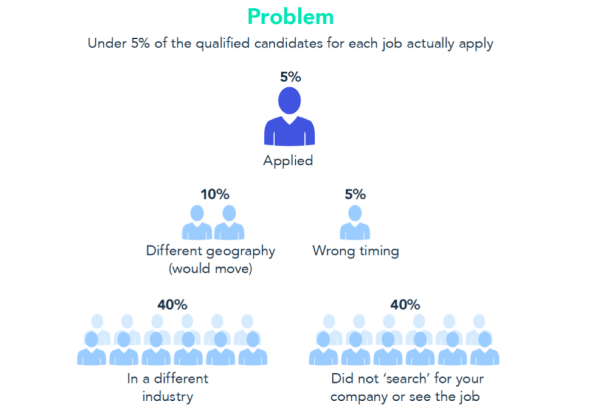
Bonus: Even if you didn’t find you perfect fit immediately after submitting your resume, don’t get discouraged – you’ll be are automatically considered for all new job postings and notified when a fit is found.
But what about companies that are not Leap partners or not in Stella’s network? How to get through their matching/screening process? The thing is that the screening is likely to be done by HR software that looks for particular keywords – and not by a human that would know that, for example, ‘online’ and ‘web’ mean pretty much the same. So, the way to pass the automated screening and reach HR human is to learn the language they use in their job postings, and adjust your resume accordingly. Mosaic.ai helps you to do this laborious fine-tuning. It’s A.I. agent analyses your resume in the context of a given job description and highlights in the resume the job’s keywords that resonate, that are missing and that are present, but in a different form. While at it, it also identifies corporate jargon and negative words in your resume, and suggests ways to make it more clear and upbeat.
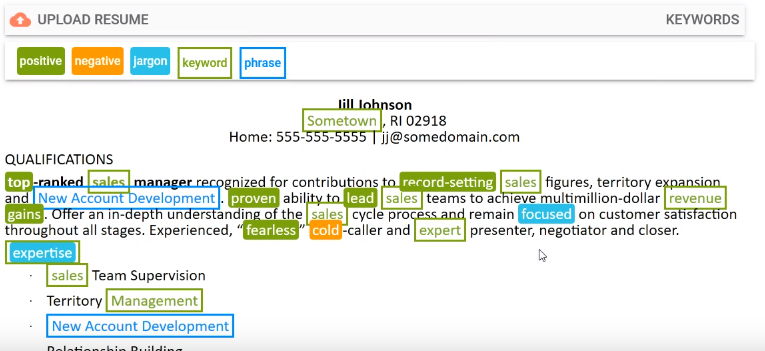
Bonus: Job description analysis also produces a list of terms you might want to refresh before going to the interview, as well as list of themes that could serve as a great conversation starters.
… keeping the place livable
In order to impact our physical space, A.I. needs to take some physical embodiment. We call that robot.
“When you ask a person what they would like a robot to do, the thing that they would like more than anyone else, is clean up the dishes in the kitchen,” said Eric Schmidt, former Google CEO. Alas, dishwashing robot is not a reality yet. However, robots are ready to take over many other types of cleaning in your household, leaving to you enjoying the cleanliness – and extra time!
Floor vacuuming robot Roomba launched by iRobot.com back in 2002 was the first practical home robot, and to these days “roomba” remains synonym with floor cleaning robot – even though nowadays there is a whole lot of such robots, for every house (and pocket) size. They are very cute and provide considerable entertainment value on top of their cleaning services – it’s fun to watch them both skillfully navigating the space and occasionally getting stuck under a low furniture or on a high threshold. Our rascal Roomba once locked us out from our house by pushing in its place the bar that we used to secure the patio door! But since we didn’t see any unauthorized charges on our credit cards from that day, we wrote the whole incident off as an accident 😉

Bonus: There are mopping versions of roombas that bring cleanliness of your floors to the next level.
Once you have experienced the magic of things like dishes and floors getting cleaned while you are away, you are likely to look for more delegating opportunities. Here are a few suggestions.

Robotic window cleaners like Winbot and Alfawise do pretty good job of cleaning your windows both inside and outside, although expect you to be around by the time the job is complete – to pick them up before they fall off the vertical surface (they typically offer 30 minutes allowance for that, and a safety rope as the last line of defense). You can finish the cleaning session by planting them on your glass shower stall and leaving the house – the robots know to finish on the lower edge of the surface, and can safely land on a pillow you thoughtfully left in your stead.

Next up are robotic pool cleaners, the likes of Kreepy Krauly Prowler, Dolphin Nautilus and Aquabot Turbo. They are not the only automated pool cleaners, but they are most autonomous ones – just plug them into power outlet and drop them into the pool. Again, there are many models to choose from – based on the type of pool you have, the type of pollutants you don’t want to have etc. But they all aim to please you with hire-and-forget-like experience.
It gets weirder from here. Meet Grillbot. Yes, you’ve guessed correctly – it scrubs grill griddle. You definitely want to be away while it’s doing its thing – the noise is loud and creepy. Good thing the longest cycle lasts only 30 minutes. But hey, it gets the job done and offers a choice of the weapons brushes you are willing to subject your griddle to – steel, brass or nylon. If nothing else, Grillbot is perfect gift to somebody who “has it all”.

Bonus: The brushes are quick-release and dishwasher-safe.

And staying on the topic of keeping your place clean (although digressing a bit from the topic of A.I.), check out Litter-Robot – automatic litter box. You just add litter and empty waste basket about once a week, and it does everything else to ensure that your cat has clean, level bed of litter any time every time . It’s pricey, but comes with 90-day return policy – go give it a try and make your cat feel (inter)stellar!
But I would argue that historically it was not cleanliness of a place that made it inhabitable. It was how dry and warm it was. It remains very important till present day – that’s why keeping roof over your head costs you about third of your paycheck, and keeping the space between the walls at comfortable temperature costs you about half of your energy bill. And while it may be up to your landlord to find a way for A.I. to reduce the cost of building maintenance (and pass the savings to you), reducing your energy bill with a help from A.I. is completely within your reach.
Technically, you don’t need an A.I. for that, of course. Just remember to dial the thermostat down to 65F before you going to sleep, then adjust it up to 70F first thing in the morning, then slide it all the way down to 60F before leaving home – and don’t forget to turn it back up when you arrive in the evening. Actually, in summer keep the indoor temperature at 75F while you are awake and 70F while you’re asleep. A bit involved, I agree, but hey, we are talking about saving planet (and money) here!
Well, a learning thermostat like Nest or Ecobee would get you out of business of courting your thermostat , and would pay for itself with the energy bill savings. Just replace your regular thermostat with it, and keep adjusting the temperature to your liking. In a week or so it will learn your schedule and temperature sensitivity, and will take it from there, leaving you to enjoy the resulting microclimate. If the microclimate is needed in a room different from the one where the thermostat is installed, no problem – just put a remote sensor there .
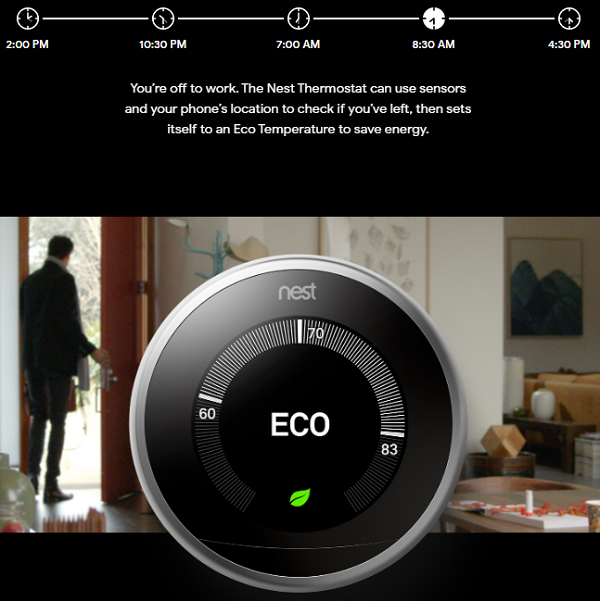
Bonus: It can display the weather forecast, and thus keep your mornings smartphone-free for longer!
Let’s step outside. Do you see that overgrown lawn of yours? No, please don’t draw back inside! Didn’t mean to trigger the guilt in you – on the opposite, wanted to show the way to solve the problem once and for all.
By the way, do you know that lawns started as a way to show off your wealth and that you can afford to own land that doesn’t produce for you? Well, robotic lawnmower could bring the showing-off to the next level – by bearing a hefty price tag and by keeping the lawn impeccable at all times, and not just for a few days after the scheduled grass cutting. Check out alikes of Worx, Hhusqvarna, and Robomow. They do require you to run a low-voltage wire around the perimeter of your lawn that would serve as an invisible fence, but take this as an opportunity to survey and appreciate the scale of your estate. After that, the robo-mower roams freely (returning to the station to recharge or wait out a rain) and gives your grass naturally looking cut – and not those artificial parallel lines human mowers usually leave behind.

Bonus: Constant trimming of grass by just a small fraction of an inch relieves the need to remove the trimmings – instead, they decompose and fertilize your lawn.
… tracking time
As you see, there is quite a number of chores that you can delegate to A.I. In fact, so many, that you might be wondering – where to start? Let me offer a suggestion – start with things that take up most of your waking non-creative time! Do you know what these things are? Care to find out? Here are a couple of A.I. tools for that.
There is no lack of automated time tracking apps – from pure quantified-self favorites like RescueTime to screen recorders for remote team management like TimeDoctor. But what makes SmarterTime stand out is its mobile-first nature: it takes full advantage of all data sources you smartphone offers, from room-level location to phone sensors readings. And all this low-level data would be overwhelming and useless, wouldn’t SmarterTime be, well, smart about using this data to guess your actual activity at the time. From workouts to meetings to coffee breaks, at the end of the day you get complete picture of where you time went, down to a minute. Want the big picture? Weekly report will highlight the most important findings. Love to crunch the raw data yourself? Just download the log in .csv format, and knock yourself out!

Bonus: If you are concerned (as you should be) with privacy of this highly-personal data, relax – SmarterTime keeps all the data on your device, and uses its servers only for data backup/restore – and only with your permission.

The only (hopefully, temporary) problem with SmarterTime is that it’s not available on iPhone. That kinda makes sense – I heard that it’s much harder to get access to all same data sources on iOS platform. So, what’s poor Apple fan to do? Use LifeCycle. It seems to use only motion/location sensors, but you might be surprised by the quality of the daily journal you get with it. It’s even more surprising given that the app doesn’t use power-hungry GPS, and relies only on WiFi/cellular connectivity data to detect your location and movement. That’s pretty intelligent, IMHO. The app offers very convenient way of adding manual entries and annotating existing ones. To add some intelligence to that beauty, the app learns your manual log habits and makes manual entry even easier – by suggesting what you are likely to log. As with SmarterTime, your data is on-device only, and accessible in plain-text format with only a few taps.
Bonus: The app exhibits another feature of intelligence – notion of context for activities. For example, it does great job of recognizing consecutive “walk”/”transport”/”walk” activities (that take me from “home” to “work” or back) as steps of a single “commute” activity.
The value of that ability to recognize contexts of activities might go beyond reducing amount of irrelevant details. It could mean more accurate accounting for time you spend on a project – and more money in your pocket, if you charge for your services an hourly rate. Timely has been in business of helping you create accurate time-sheets for a while, and their latest invention – Memory Tracker – takes that to the next level: it creates the time-sheet for you.
I’ll pause to let that sink in.
It might seem like a magic, but here is what’s happening behind the scenes: after you connect the Memory Tracker with tools you use, it starts analyzing your activities to see what projects they might be related to. For example, if you stepped out of the office for a business meeting in a cafe, the whole time you spent outside the office gets marked as devoted to the subject of the meeting. Or if your preso ran longer than was originally scheduled in your calendar, the whole time you used your presentation tool will be accounted for. And so on. All you need to do (besides delivering massive value to your customers) is to review the time-sheet the next morning. While giving you the opportunity to adjust the time-sheet, the review process also provides Memory Tracker with feedback it needs to learn and get better. The review itself is very easy as well. You don’t need to reverse-engineer the reasoning behind the tool’s decisions – all the related activities are displayed as a timeline right next to the time-sheet.
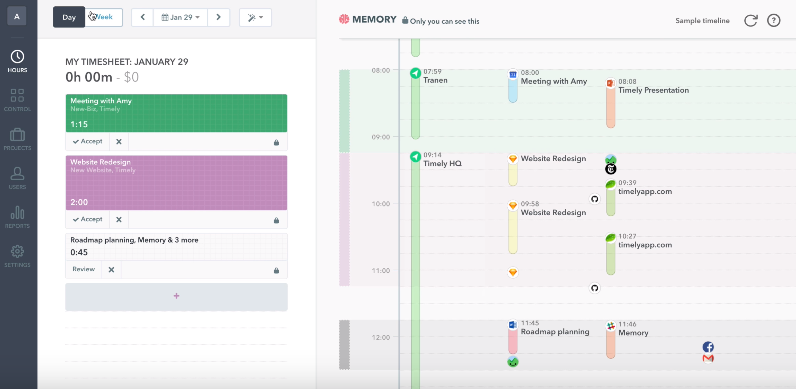
Bonus: Even if your boss pays for Memory Tracker services, s/he doesn’t see any of the activities it collects for you – only the timesheets you have approved. So, don’t let your privacy paranoia (if any) justify the pain and sweat of manual time tracking – just do what you love, and let the machine do the rest.
… planning the day
So, one way or another, you’ve got the picture of your time expenditure. Is it pretty? Do you like it? Or would you rather it be somewhat different? Have bit more of this and bit less of that? Don’t think you are just being capricious – where your time goes is VERY important. You’ve got only so much of it, and once you run out of time, you’re dead. Literally. So go ahead, make a list of what do you want to do with your time. It would be called, rather naturally, a “to-do list”.
There is a small problem, though. We humans are pretty good at writing to-do lists. What we are not good at is operating off of a to-do list. (Want an evidence? 40% of to-do items never gets done.) It’s because selecting ‘right’ thing to do from a long list is very stressful and mentally taxing. However, what we are good at operating-wise is attending appointments. It’s because with an appointment, it’s very clear when, where and what you should do, and who will be pissed off if you don’t. Smart people realized that, and invented making appointments for things in to-do lists. It’s rather unnaturally called “time blocking”.
With time blocking, much more mental energy gets devoted to the actual task, and indeed much more things gets done. Mind you, it still requires prioritizing things from to-do list (process called “scheduling”), and re-prioritizing things when life gets on the way (“re-scheduling”). But the good news is that (re-)scheduling can be delegated. Until recently, the only (rather expensive) way to outsource this was to hire an administrative assistant. And then along came A.I.
But before we bring in the big guns…

In case you enjoy putting together your daily schedule, and it’s the “rescheduling-when-things-pop-up” part that drives you nuts – there is a class of tools that I call “time-scribers“. All they do is take prioritized list of tasks and a starting time, and mechanically ascribe start time to each task. As you can imagine, for this to work, every task has to have its duration explicitly specified, otherwise it assumes some default duration – say, one “pomodoro” (25 minutes). And whenever you change priority or duration of a task, the tool mechanically updates the rest of the schedule – except for the “pinned” tasks (tasks for which you fixed the start time, ’cause, you know, some things in life are just non-negotiable). It’s pretty straightforward functionality, but the net effect – you knowing what you should be focusing on at any given moment – could be life-changing.
The most spartan time-scriber out there is Flax – Speed Schedules app. Every task is just one line, so the whole schedule fits on the phone screen. No marking a task as complete – you just update start time of the next one. No hooking up with an external calendar – you just quickly add appointments as pinned tasks. No baggage of unfinished todos creeping into your new day – you start your schedule afresh. It’s just lean, mean, and … awesome.
Now, if manually importing your appointments is a hassle (and/or an excuse for not putting your tasks into calendar), check out Sorted³. It can sync up with your Google and/or Office 365 calendars, and keeps your tasks neatly organized into lists. When it comes to time-scribing, it can do “buffering” – reserving a “buffer time” between events instead of placing them back-to-back.
Bonus: If you take notes within the app, you can easily “reorganize” parts of them into a new tasks with a simple select-and-drag swipe.
Source: Sorted³
If you’d like go further down the road of pulling tasks from different systems into your schedule, Focuster is the man. Err… the hub. With Zapier integrations, it can pull tasks from gazillion other apps – and update other apps once a task marked as competed. It will even automatically split longer tasks into chunks to fit a packed schedule. And warn you if there is just no room for some of the tasks.

Bonus: “Time Blocking” feature allows you to create “zones” in your calendar where tasks from a given list can be placed. This is an easy way to make sure that your “home” chores don’t get scheduled during “work” hours. The concept is arch-important on its own (as we’ll see later with “time maps”), so I find overriding of the term “time blocking” here rather surprising.
Now, for those among us who expect more intelligence from time management technologies – meet auto-schedulers.
We have already seen first signs of intelligence with Focuster’s “Time Blocking”, where the tool had to perform some search for a good spot in the calendar, rather than just place tasks one right after the other. But with time-scribers, the mental heavy-lifting of scheduling – namely, prioritizing – still remains your responsibility. Even when tasks’ priority even it’s not a question of your momentary mood or timeless values.
In many cases, creating a good schedule is “simply” a matter of satisfying all deadlines while adhering to one’s basic preferences and systems. It might sound easy, until you try to do that a few times a day – in response to unforeseen changes. The best way to deal with that is to have fewer deadlines (and reduce planning to maintaining systems) and to allow for fewer disruptions – Cal Newport is an example of how indeed successful that approach can be. But if it’s just not what your workday looks like, the only way to stay sane and on schedule is to have “Update Schedule” button in your calendar.
That’s exactly what SkedPal offers.
Well, actually, you could see a button like that in some time-scribers as well, but there it just runs the ‘time ascribing’ drill – something that other time-scribers do instantly on any update. But in SkedPal, “Update Schedule” really analyses current state of affairs and comes up with new plan of attack.
Workable schedule should take into account estimated duration of your tasks, their deadlines, and your preferences/systems. The first two components is customarily part of majority of “time management” systems, although deadlines are used for warnings at best. (Like, “with the schedule you just came up, silly human, you don’t make it in time… Nope, that doesn’t work either, try again… Isn’t it fun to move these Gantt bars around, eh?!..”) SkedPal uses deadlines to drive the process of creating the schedule. There, you could also get a warning about missing deadlines, but only when it’s actually not possible to come up with a workable schedule given current set of objectives. In this case, the misfit tasks are placed into “Hot list” and you have to make some adjustments before you could successfully “Update Schedule”. We’ll come back to that later.
When it comes to your preferences and systems, you’d use “time maps” to communicate them to SkedPal. “Time mapping” is just identifying time periods that you prefer to use for certain kind of tasks. For example, you mark first two hours of every workday as the prime spot for creative work. You could also identify second and third preferences – for example, 10am-noon could be used for creative work as well, but not as effectively, so creative tasks would be placed there only if available “prime” time is not sufficient to clear the deadline. Another important feature of “time maps” is that they can overlap – say, the same 10am-noon can be “prime” time for research tasks. All other things being equal, SkedPal would give preference to the task that is higher in your list – the order there reflects relative priority of tasks. You can see how “time maps” offer a balance of guidance and flexibility when it comes to scheduling tasks.
But what is really great about SkedPal is that it really internalized shifting schedule as a fact of modern life, and made it its mission to help you have a workable schedule despite all the adversity. For example, to help you eliminate “hot list” – which is actually indication of the overwhelm – it guides you through task re-prioritization: from making sure that you checked off all completed items, to suggesting more realistic deadlines, to shortlisting ‘competing’ tasks and appointments for easier re-ordering. That feels if not magical, then intelligent for sure!

[SkedPal snapshot]
Bonus: Again, SkedPal is on the mission, so many more smart features and neat tools are bound to come.
And yet… Guess, what is THE best way to deal with schedule overwhelm? That’s right – delegate some of your tasks. Take some things off you plate. I bet there is somebody in your household or in your team who has spare cycles. How would you know? TimeHero would tell you.
You know how some unsolvable problems (like un-crossing two non-parallel lines in 2D space) become trivial with just one more dimension (in this example, lifting one line into 3rd dimension)? TimeHero might not have all the plan-fu chops of the SkedPal (yet), but it gives you access to the second dimension of time: time of other people. And while it doesn’t (yet) automatically re-assigns non-fit tasks to somebody else, it immediately tells you if re-assignment you suggesting would solve the conundrum. Solve not just in terms of “if I give this task to this person, would (s)he have time to finish it by the deadline”; since TimeHero allows for dependencies between tasks, a task re-assignment could domino the reminder of the project into the green zone! Cool, eh?!

Bonus: Speaking of task dependencies – TimeHero allows you to setup a repeating sequence of tasks as a template for a project. Both start and due dates of any task in the template can be set relative to another task in the template – for example, first draft is due 3 days from first meeting with client. So, once the date for the kick-off meeting is set – BOOM, the whole project finds its place in the calendars of all parties involved! And when some things change, as they always do, the rest of the project gets rescheduled accordingly.